hardingfv32 wrote:
Are you referring to double fences?
yes, I did, in the context that you said, they are definitely a benefit.
If this is the case, and you said or assumed earlier that the flow pattern on the MCL wing/flap was "what they wanted",
I ask, why in your opinion have many (most/all?) teams gone away from the dual "fence" (slot gap separator), to a central
one this year.
If this "fences" are so beneficial in terms of keeping the flow attached, more should be better - no?
I think Flyn made some good&valid points in regards to the use/benefit of "fences" on some aircraft wing configurations.
A endplate/winglet by itself will reduce cross flow tendency along the wingspan, this was why I pointed out that in your
example (paper) the wing did not have one.
Therefore any effects (positive or negative) could be different if you use them in a different configuration.
I guess, what I want to say, is keep the aspect ratio and the "loading" of the wing in mind, when you compare it to aviation wing data / tests.
A F1 (race car) wing is quite specific, and not all effects involved "scale" well, so drawing conclusions from one application to another can be misleading at times.
So before we go and "hand out the chocolate" for "absolutely right" to early, mind about it in a bit more detail and from some different perspectives.
I'm not trying to dig on or belittle anyone here, far from, just want to prevent people from jumping to conclusions to soon, that's all.
Enjoy the debate


